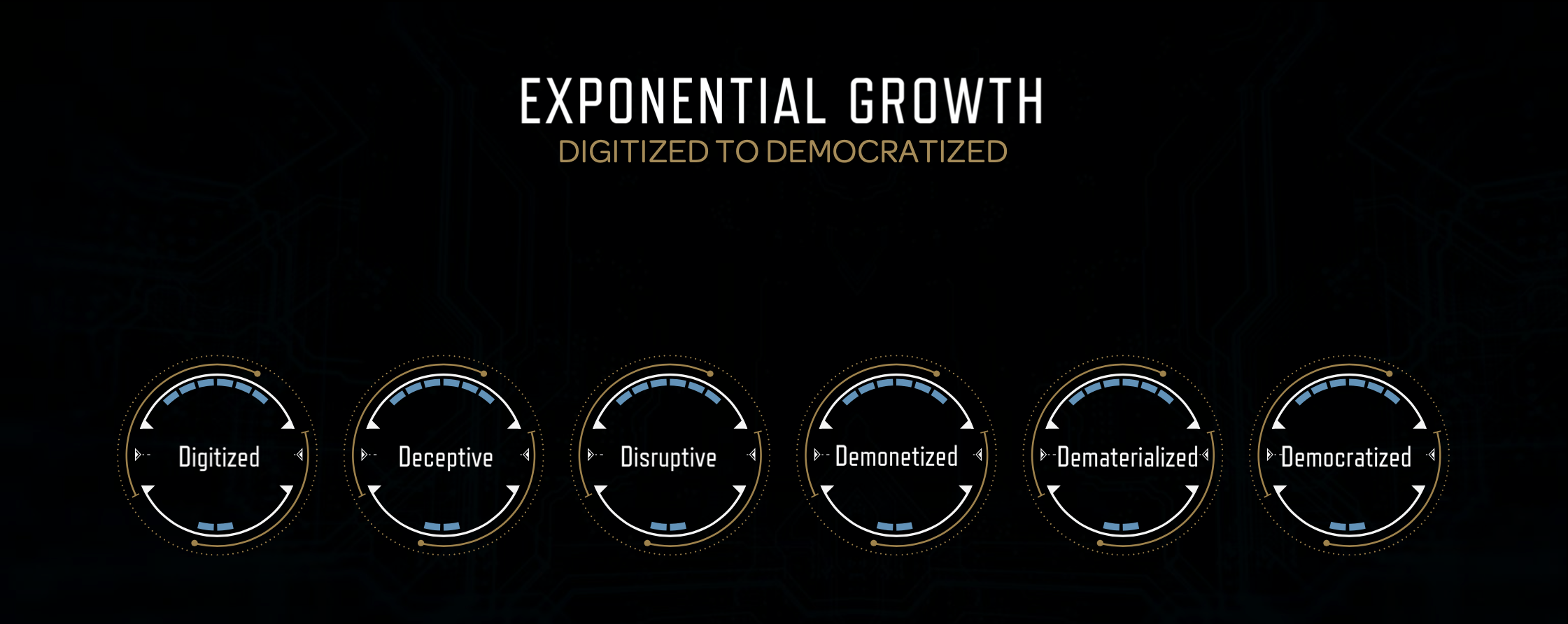Why you need to start thinking exponentially
on 10 March 2020 for CompaniesDuring our latest Meeting of the Minds (our quarterly meetings with all Exellysts) we invited Pieter Van Leugenhagen, Co-Founder & International Growth Director at Yondr, to share his key takeaways from the very first SingularityU Summit in Belgium. One of the things that really stuck with us from his one-hour talk was his six-minute introduction about exponential growth. Pieter explained that the ability to think exponentially is one of the most important skills for those looking to succeed in today’s tough economic climate. He challenged us to shift our mindsets and to ‘see ahead of curve’ in order to make the right decisions for future success.

What is exponential growth?
Exponential growth – the idea is that something grows in relation to its current value – shows up in many real-world tech situations. Perhaps the best-known example is Moore’s Law, which holds that the speed and power of computers roughly doubles every two years, resulting in the exponential growth of computing power. Exponential technological increases have been observed in areas ranging from DNA sequencing to internet speeds, hard drive storage and memory. This has led technological futurist and one of the Singularity University Founders Ray Kurzweil to theorize that the 21st century will see the equivalent of 20,000 years’ worth of 20th-century-level progress.

The 6 D’s of exponential growth?
During his talk, Pieter introduced us to the theory of the 6 D’s of Exponential Growth, a concept created by Peter Diamandis, Executive Chairman & Co-Founder of Singularity University.
The framework of the 6D’s can help you navigate and predict the journey that an exponential technology will take. As an area becomes information-enabled, you can expect to see the following things:
Digitized
The key to exponential growth is digitizing a technology so that it becomes an information science and can be managed by computers.
Deceptive
Initial growth takes place in labs and research institutions, making development almost imperceptible to the general public.
Disruptive
Once the technology has been proven in real-world situations and can out-perform incumbent industries in both effectiveness and cost, it becomes disruptive and makes the previous paradigm obsolete.
Dematerialized
Dematerialization can mean different things to different industries. For physical devices, it can refer to miniaturization of devices (such as 3D printers becoming smaller) or the elimination of single-use devices (such as incorporating a GPS tracker into a smartphone). For information products, it can mean replacing once tech for another (such as Netflix’s internet streaming heralding the death knell for video and DVD rental). For manufacturing processes, dematerialization can refer to materials or processes being removed from the chain.
Demonetized
The fifth stage that all disruptive technologies pass through is demonetization where the economies of scale (such as mass production) make products more affordable or digital products more accessible through things such as increased internet speeds or lower costs (media streaming services).
Democratized
The final stage of exponential growth is where an ever-increasing percentage of the global population has access to the tech or the service. For example, an Indian factory worker with a cheap smartphone and internet connection has access to the exact same platforms as a billionaire.

The video above illustrates the 6 D’s theory nicely using the example of 3D printing, but let’s have a look at another example; digital photography.
Digital Photography: An example of the 6D’s in action
To illustrate how powerful and devastating exponential growth can be for firms who fail to think exponentially, let’s have a look at the cautionary tale of Kodak. In 1975, a Kodak employee by the name of Steven Sasson invented the world’s first digital camera. Weighing in at 3.6kg, the camera shot images at just 0.01 megapixels (MP) – or 100 by 100 pixels. Over the following two decades, digital photography made painfully slow progress and by 1996, 2MP images were the best that leading digital cameras of the time could muster.
But then in 1997, a guy named Philippe Kahn, who you may have heard of, changed digital photography forever. He took this photo of his newborn daughter Sophie and sent it via email to over 2,000 contacts, thus helping to usher in the camera phone era. Kahn christened his new technique “Instant-Picture-Mail” and approached Kodak and Polaroid only to be rebuffed by both firms.
 © Philippe Kahn
© Philippe Kahn
Yet Kahn’s technique created a seismic shift in people’s perception of digital photography. Suddenly, photography wasn’t just about image quality; it was about sharing experiences, and this sharing aspect became more important than the quality of the photos. Kahn’s technique helped make digital photography disruptive because people saw the potential for sharing experiences via photographs in real-time.
When Kahn’s company LightSurf got their ‘Picture-Mail phone’ to market in 1999 (thanks to a partnership with J-Phone and Sharp), film photography started to be demonetized as suddenly millions of people could take as many photos as they wished without ever buying or developing a roll of film. As cameras began to be introduced to mobile phones, digital photography became democratized. To illustrate the profound speed and severity of this exponential change, take a moment to consider that in the same year Kodak went bankrupt, 2012, Facebook bought Instagram – a firm with just 12 employees – for US$1 billion.
The challenge of thinking exponentially
The crux of the matter is this: it’s not enough to merely know about exponential growth; we need to train our minds to think exponentially. As much as we might want to, we aren’t naturally inclined to think this way. We think locally and linearly, and our brains are extremely good at extrapolating linear steps. For instance, if I ask you to say where are you going to be in 30 steps, you’d be able to roughly guess where you’d be to a high degree of accuracy.
But what if I asked you to imagine taking 30 exponential steps where each step was double the previous one? 1, 2, 4, 8 and so on. Where would you be then? 100 meters away? A million meters away? You’d actually be a billion meters away and would have circumnavigated the globe 26 times! That difference between 30 meters and a billion (and failing to grasp it) is precisely what makes exponential technology so devastating for incumbent industries that fail to grasp it.
 © Singularity Hub
© Singularity Hub
Final thoughts
Are you ready for the innovations of tomorrow? We believe that the key to staying ahead of the curve lies in thinking exponentially and making the right decisions today that keep you on the right path moving forward. Whether you’re a company or a tech talent, visit our website today and find out how we can help.
Tags: exponential thinking , innovation




